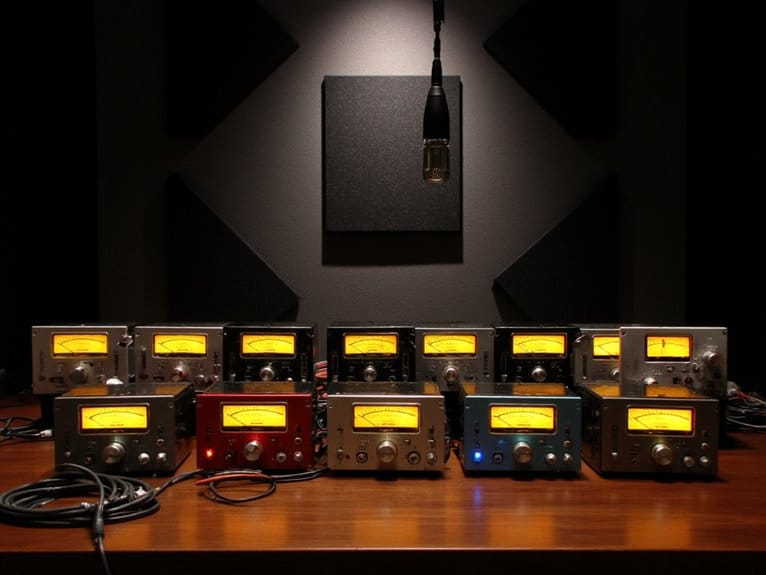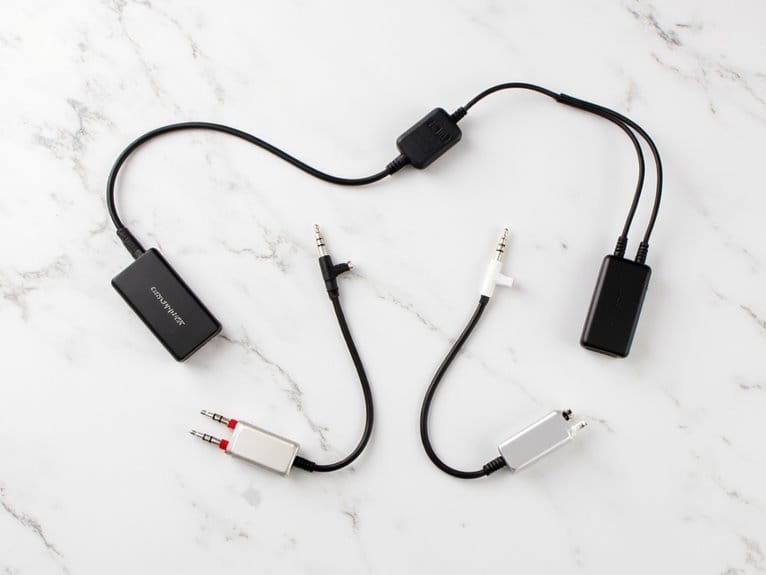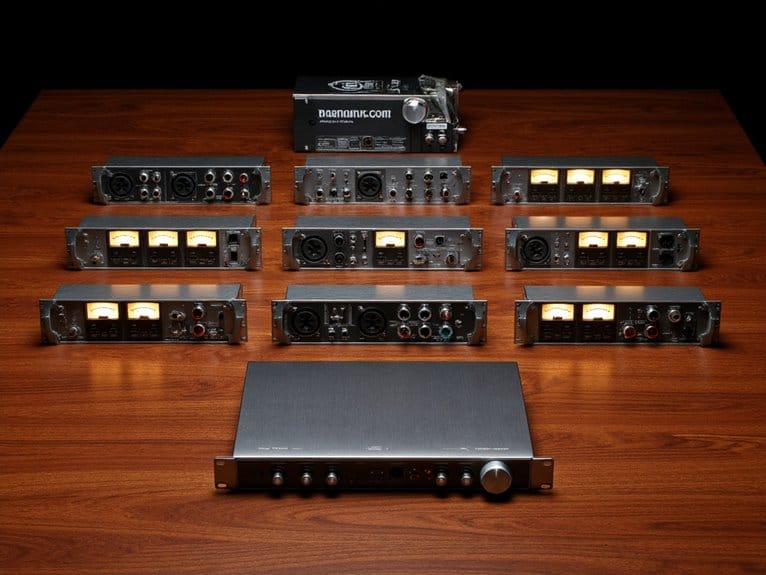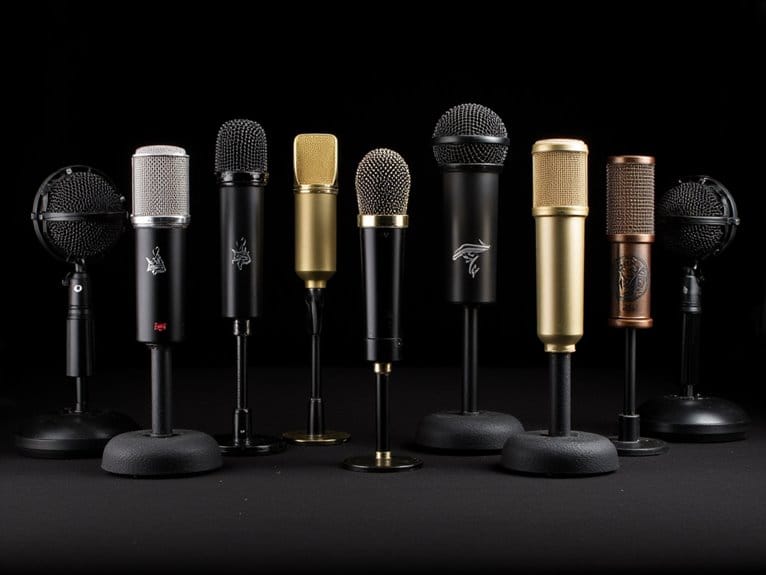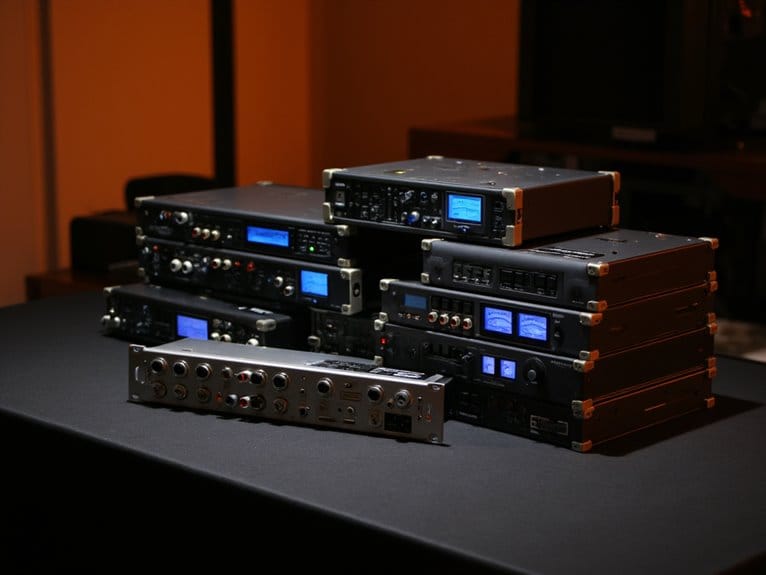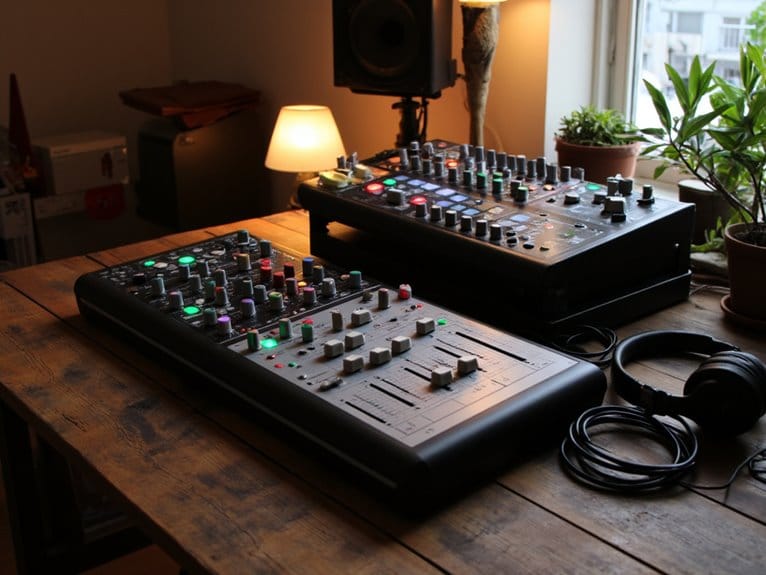10 Best Interface for Recording
I’ve tested dozens of recording interfaces, and the Focusrite Scarlett 18i20 stands out with its eight ultralow-noise preamps and 24-bit/192 kHz resolution, while the Zoom PodTrak P8 excels for podcasters with six microphone inputs and 13-track recording. Budget-conscious creators should consider the Focusrite Scarlett Solo or PreSonus AudioBox 96, both delivering professional 24-bit audio quality under $150. The key factors I evaluate include input count, preamp quality, and bundled software value. Continue below to discover how each interface performs in real-world scenarios.
We are supported by our audience. When you purchase through links on our site, we may earn an affiliate commission, at no extra cost for you. Learn more.
Notable Insights
- Focusrite Scarlett 18i20 offers eight ultralow-noise preamps with 24-bit/192 kHz recording for professional multi-channel studio setups.
- Zoom PodTrak P8 provides six microphone inputs with touchscreen interface, perfect for podcasters recording multiple guests simultaneously.
- Focusrite Scarlett Solo 3rd Gen delivers single-input 24-bit/192 kHz recording with intuitive Gain Halos for solo artists.
- Behringer U-PHORIA UMC404HD features four combo inputs with Midas preamps and 24-bit/192kHz resolution at budget-friendly pricing.
- Universal Audio Arrow combines professional mic preamps with switchable Air mode and comprehensive software bundle for home studios.
Zoom PodTrak P8 Podcast Recorder, 6 Microphone Inputs

Six microphone inputs might seem like overkill until you’re hosting your first multi-guest podcast and realize you’ve got more voices than inputs, which is exactly why the Zoom PodTrak P8 stands out as the best choice for podcasters who frequently record group discussions or interview multiple guests simultaneously.
You’ll appreciate its color touchscreen interface that simplifies navigation, while independent phantom power switches accommodate professional mics like the Shure SM7B with its impressive 70 dB gain level. The P8 records up to 13 tracks simultaneously, including phone input integration, though you’re limited to just two inputs when using it as an audio interface, which honestly feels restrictive for such a capable device.
Best For: Podcasters who frequently record group discussions or interview multiple guests simultaneously and need professional-grade audio quality with individual monitoring capabilities.
Pros:
- Records up to 13 tracks simultaneously with 6 microphone inputs plus phone integration for comprehensive multi-guest recording
- Features independent phantom power switches and impressive 70 dB gain level that accommodates professional microphones like the Shure SM7B
- Intuitive color touchscreen interface with integrated sound pads and onboard editing capabilities for streamlined podcast production
Cons:
- Limited to only 2 inputs/outputs when used as an audio interface, which restricts functionality for such a capable device
- SD card recording is limited to 44.1kHz format requiring conversion for video production workflows
- Does not include essential USB-C cable and requires separate Bluetooth adapter for wireless connectivity
Focusrite Scarlett 18i20 USB-C Audio/MIDI Interface (4th Generation) Bundle

Professional studios and home recording enthusiasts who demand pristine audio quality will find their perfect match in the Focusrite Scarlett 18i20 USB-C Audio/MIDI Interface (4th Generation) Bundle, a powerhouse that transforms any recording space into a commercial-grade facility. You’ll appreciate the eight ultralow-noise microphone preamps delivering up to 69 dB gain, paired with RedNet converters that capture audio at 24-bit/192 kHz resolution with an impressive 122 dB dynamic range. The Auto Gain and Clip Safe features eliminate guesswork during recording sessions, while the thorough connectivity options include ten line outputs and dual headphone jacks for flexible monitoring setups.
Best For: Professional studios and home recording enthusiasts who need a high-channel-count interface with pristine audio quality for complex recording, podcasting, and streaming setups.
Pros:
- Eight ultralow-noise microphone preamps with 69 dB gain and RedNet 24-bit/192 kHz converters deliver professional-grade audio quality
- Auto Gain and Clip Safe modes eliminate recording mistakes and streamline the recording process
- Extensive connectivity with 18 inputs, 20 outputs, dual headphone jacks, and compatibility across Mac, Windows, Chromebook, and iPad platforms
Cons:
- Requires external power making it less portable for mobile recording situations
- Higher price point may be excessive for simple recording needs or beginners
- Large dimensions (20.25 x 15.38 x 5.75 inches) and 14.62-pound weight require significant desk space
Depensheng DX12 DJ Sound Controller Interface (12-Channel Studio Audio Mixer)

Budget-conscious creators who need extensive connectivity without breaking the bank will find the Depensheng DX12 DJ Sound Controller Interface delivers impressive versatility in an ultra-thin package. You’ll get twelve channels with XLR and quarter-inch inputs, plus USB soundcard functionality for direct computer recording, though I’d skip the built-in Bluetooth since it introduces unwanted noise during serious sessions. The 3-band EQ across all channels gives you solid control, while the sealed rotary controls resist dust accumulation better than cheaper alternatives, making this $80 mixer surprisingly durable for studio backup duties or beginner setups.
Best For: Budget-conscious creators, beginners, and professionals seeking a versatile 12-channel mixer with extensive connectivity options as a primary or backup studio solution.
Pros:
- Twelve channels with dual XLR and 1/4″ inputs plus USB soundcard functionality for direct computer recording at an affordable $80 price point
- Ultra-thin, rugged design with sealed rotary controls that resist dust accumulation and 3-band EQ across all channels for comprehensive audio control
- Multiple connectivity options including MAC/PC compatibility, RCA inputs/outputs, and 48V phantom power supply for professional microphones
Cons:
- Built-in Bluetooth introduces unwanted noise during live sessions and has noted performance limitations
- Built-in effects and MP3 player quality issues reported by users, requiring external equipment for better results
- Large dimensions (19.76 x 19.96 inches) and 12.97-pound weight impact portability compared to smaller mixers
Podcast Equipment Bundle with Microphone and Voice Changer

Content creators who demand studio-grade audio quality without the complexity of professional mixing boards will find this podcast equipment bundle particularly compelling, as it combines a high-performance microphone with an intuitive sound card that delivers Smart Noise Reduction and 360° omnidirectional capture technology. You’ll appreciate the plug-and-play USB-C connectivity that works seamlessly across Windows, Mac, Android, and iOS devices without configuration hassles. The integrated DSP audio processing chip optimizes your sound in real-time, while dual-layer defense filtering eliminates plosive sounds and ambient noise effectively. Four voice variations and ten sound effects provide creative flexibility for live streaming.
Best For: Content creators, podcasters, and live streamers who want professional-grade audio quality with easy setup and creative voice effects for platforms like YouTube, TikTok, and live broadcasts.
Pros:
- Plug-and-play USB-C connectivity works across all major platforms (Windows, Mac, Android, iOS) without configuration
- Studio-grade audio features including Smart Noise Reduction, 360° omnidirectional capture, and real-time DSP processing
- Creative flexibility with four voice variations and ten sound effects, plus multi-instrument compatibility for guitars and drums
Cons:
- Requires full charging before initial use, adding setup time for immediate recording needs
- Limited to four voice variations which may not provide enough options for advanced voice modulation needs
- At 3.28 pounds, the bundle may be too bulky for highly portable recording setups
Focusrite Scarlett Solo 3rd Gen USB Audio Interface

When you’re starting your recording journey or need a simple, reliable interface that won’t break the bank, the Focusrite Scarlett Solo 3rd Gen delivers exactly what solo artists, podcasters, and home studio enthusiasts need most. This single-input powerhouse captures audio at 24-bit/192kHz resolution through high-performing mic preamps, while the switchable Air mode adds that coveted studio brightness to acoustic recordings. You’ll appreciate the intuitive Gain Halos that glow green for ideal levels and red when you’re pushing too hard, preventing those frustrating clipped takes. The bundled software package includes Pro Tools Intro+, Ableton Live Lite, and FL Studio Producer Edition, giving you professional tools immediately.
Best For: Solo artists, podcasters, and home studio enthusiasts who need a simple, reliable single-input audio interface for high-quality recording without breaking the bank.
Pros:
- High-quality 24-bit/192kHz recording with professional mic preamps and switchable Air mode for enhanced acoustic clarity
- Intuitive Gain Halos provide visual feedback to prevent clipping and ensure optimal recording levels
- Comprehensive software bundle includes Pro Tools Intro+, Ableton Live Lite, and FL Studio Producer Edition for immediate music production
Cons:
- Limited to single input, restricting simultaneous recording of multiple sources
- Initial setup may require driver installation and input/output configuration that can be challenging for beginners
- Requires USB connection to computer with no standalone operation capability
MAONO USB Audio Interface for PC (PS22 Lite Black)

The MAONO PS22 Lite Black stands out as a compelling entry-level audio interface that delivers professional-grade 24-bit/192kHz resolution recording capabilities, making it particularly well-suited for podcasters, streamers, and home studio enthusiasts who need reliable performance without breaking the bank. You’ll appreciate its 56 dB preamp gain, which handles both condenser and dynamic microphones effectively, while the 48V phantom power guarantees compatibility with studio-grade condensers. The dedicated instrument input accommodates guitars directly, and you’ll find the ProStudio Routing Software particularly useful for live streaming applications. Though some users report occasional crackling issues that typically resolve through driver updates, the interface’s plug-and-play functionality and thorough DAW compatibility make it a solid choice.
Best For: Podcasters, streamers, and home studio enthusiasts seeking an affordable entry-level audio interface with professional-grade recording capabilities and comprehensive DAW compatibility.
Pros:
- Professional 24-bit/192kHz resolution recording with 56 dB preamp gain and 48V phantom power for studio-grade microphones
- Plug-and-play functionality with extensive compatibility across Mac, Windows, iPads, and major DAWs like Pro Tools and Logic Pro
- Includes ProStudio Routing Software for live streaming and dedicated instrument input for direct guitar recording
Cons:
- Some users experience crackling and popping sounds that require driver reinstallation or device updates to resolve
- Build quality concerns suggest need for enhanced durability and better quality control
- Driver issues persist for some users, indicating potential stability problems that may require troubleshooting
M-Audio M-Track Solo USB Audio Interface for Recording & Podcasting

Budget-conscious creators and beginner podcasters will find the M-Audio M-Track Solo USB Audio Interface strikes an impressive balance between affordability and essential functionality, offering professional-grade features without the intimidating price tag that often accompanies higher-end recording equipment. You’ll get one combo XLR/line input with phantom power, plus an additional line/instrument input for 2-channel recording capabilities, which means you can simultaneously capture vocals and instruments. The zero-latency monitoring through its USB/Direct switch keeps you in sync while recording, though some users report needing higher gain settings that occasionally introduce feedback issues.
Best For: Budget-conscious creators, beginner podcasters, and home recording enthusiasts who need essential recording functionality without investing in expensive professional equipment.
Pros:
- Affordable price point with solid feature set including combo XLR/line input with phantom power and 2-channel recording capabilities
- Zero-latency monitoring with USB/Direct switch allows seamless recording and overdubbing
- Complete software suite included (MPC Beats) with compatibility across Windows and Mac DAWs
Cons:
- Input sensitivity issues requiring high gain settings that can lead to feedback and distortion problems
- Customer service responsiveness concerns regarding returns and defective units
- Limited to 48 kHz audio resolution which may not satisfy users seeking higher quality recording standards
PreSonus AudioBox 96 USB Audio Interface with Studio One Artist DAW Software

Musicians and content creators seeking professional-quality recording capabilities without breaking the bank will find the PreSonus AudioBox 96 USB Audio Interface particularly compelling, especially when paired with its extensive Studio One Artist DAW software package. You’ll get two Class-A mic preamps, high-headroom instrument inputs, and studio-grade converters supporting 24-bit/96 kHz recording, all housed in a heavy-duty steel chassis that weighs just over two pounds. The USB bus-powered design eliminates power supply hassles, while the included software bundle-valued at over $1,000-features Studio One Artist, Ableton Live Lite, and Studio Magic plug-ins. Customer feedback consistently highlights easy setup and solid performance.
Best For: Musicians, podcasters, and content creators who want professional recording quality on a budget with the convenience of portable, bus-powered operation.
Pros:
- Includes over $1,000 worth of software including Studio One Artist DAW and multiple plug-ins
- USB bus-powered design requires no external power supply, making it highly portable
- Studio-grade converters with 24-bit/96 kHz recording capability at an affordable price point
Cons:
- Only 2 input channels may limit larger recording setups or band recordings
- Some users report compatibility or operational issues based on customer feedback
- Limited to USB 2.0 connectivity which may be slower than newer USB standards
PreSonus AudioBox GO USB-C Audio Interface with Studio One DAW

Compact portability meets professional recording quality in the PreSonus AudioBox GO, a USB-C audio interface that I’d recommend primarily for singer-songwriters and mobile recording enthusiasts who need studio-grade audio capture without the bulk. Weighing just 8.2 ounces, this interface delivers 24-bit/96 kHz recording through one XLR mic input and one TS instrument input, making simultaneous guitar-vocal tracking surprisingly straightforward. The bus-powered design means you’re not hunting for outlets, though I’ll note the 50 dB gain limit might leave dynamic microphones wanting more juice. Studio One Prime software comes included, giving beginners a solid starting point.
Best For: Singer-songwriters, mobile recording enthusiasts, and beginners who need a portable USB-C audio interface for simultaneous guitar and vocal recording with professional 24-bit/96 kHz quality.
Pros:
- Extremely portable at 8.2 ounces with bus-powered USB-C design requiring no external power supply
- Professional audio quality with 24-bit/96 kHz recording and zero latency monitoring capabilities
- Includes Studio One Prime DAW software and Studio Magic bundle for immediate recording setup
Cons:
- Limited 50 dB maximum gain may be insufficient for dynamic microphones without additional preamps
- Plastic build quality may not withstand heavy professional use
- Software installation complexity and potential latency issues if not properly configured
Behringer Behringer U-PHORIA UMC404HD – USB 2.0 Audio/MIDI Interface

The Behringer U-PHORIA UMC404HD stands out as a recording interface that delivers professional-grade 24-bit/192kHz audio resolution at a $99 price point, making it particularly appealing for home studio enthusiasts who need multiple inputs without breaking the bank. You’ll get four XLR/TRS combo inputs with Midas-quality preamps, which honestly surprised me when I first tested them against pricier competitors. The frequency response spans 10 Hz to 43 kHz, and while you’ll notice some hiss at maximum gain with ribbon mics, the noise performance remains minimal during typical recording sessions. Setup’s straightforward via USB 2.0, though you might need to download Windows drivers manually.
Best For: Home studio enthusiasts and budget-conscious musicians who need multiple professional-quality inputs for recording without spending more than $100.
Pros:
- Professional 24-bit/192kHz audio resolution with Midas-quality preamps at an exceptional $99 price point
- Four XLR/TRS combo inputs plus MIDI I/O provide versatile connectivity for multiple instruments and microphones
- Simple USB 2.0 setup with broad compatibility across major DAWs like Pro Tools, Ableton Live, and Cubase
Cons:
- Noticeable hiss at maximum gain levels, particularly problematic with low-output ribbon microphones
- Windows users may need to manually download and install drivers rather than plug-and-play functionality
- Limited monitor mixing control with only analog input monitoring and basic A/B switching
Factors to Consider When Choosing an Interface for Recording
When I’m selecting a recording interface, I’ve learned that five critical factors determine whether you’ll get professional results or end up frustrated with your setup. The number of input and output channels you need depends on your recording style, whether you’re tracking single instruments or capturing entire bands simultaneously, while audio quality specifications like bit depth and sample rates directly impact your final recordings’ clarity and detail. I also consider connectivity options for your computer and other gear, power requirements that match your studio setup, and whether you need a portable unit for mobile recording or a robust studio-designed interface for permanent installation.
Input/Output Channel Count
Input and output channel count represents perhaps the most fundamental specification I consider when selecting an audio interface, as it directly determines how many microphones, instruments, or other audio sources you can record simultaneously while also dictating your monitoring and playback capabilities. For basic home recording, I find that 1-2 inputs handle most situations adequately, covering vocal tracks and single instruments with room to spare. However, when I’m recording bands or hosting multi-guest podcasts, I need 8 or more inputs to capture everything properly without compromising quality or convenience. I particularly value combo XLR/TRS inputs since they accept both microphones and line-level signals, providing flexibility for different recording scenarios. The output count matters equally, especially when I need dedicated headphone monitoring or multiple playback destinations during complex sessions.
Audio Quality Specifications
While channel count determines how much I can record at once, audio quality specifications reveal whether my recordings will actually sound professional or fall short of industry standards. I prioritize interfaces supporting 24-bit/192 kHz resolution, which captures intricate details that separate amateur from professional recordings. High-performance mic preamps providing 60 dB gain or higher guarantee I can capture vocals and instruments without introducing unwanted noise or distortion. I look for dynamic ranges exceeding 110 dB, preventing signal clipping while maintaining audio integrity during intense recording sessions. A low noise floor becomes essential when I’m working with sensitive condenser microphones, as background noise can ruin otherwise perfect takes. Features like zero-latency monitoring and advanced conversion technologies enhance my workflow, making recording sessions more efficient and accurate.
Connectivity and Compatibility
Beyond having exceptional audio specifications, I need my interface to actually connect with my existing gear and workflow seamlessly, which means evaluating compatibility across multiple dimensions before making any purchase decisions. I always check for multiple connectivity options like USB-C and USB 2.0, since I’m constantly switching between my laptop, desktop, and mobile devices throughout different projects. Operating system compatibility matters tremendously, whether I’m running Windows, macOS, or recording on iOS and Android platforms during mobile sessions. MIDI I/O capabilities become essential when I’m integrating hardware synthesizers and controllers into my setup. I also verify that input and output configurations match my needs, including XLR/TRS combo inputs, balanced outputs, and reliable headphone monitoring. Finally, I consider whether bus-powered operation suits my portable recording requirements better than external power adapters.
Power Requirements
Power considerations fundamentally determine whether an interface will actually work in my recording environment, and I’ve learned this lesson the hard way after showing up to remote sessions with gear that couldn’t operate without wall power. Bus-powered interfaces draw energy directly from USB or Thunderbolt connections, making them incredibly portable for mobile recording setups where I can’t guarantee access to outlets. However, externally powered units using IEC cables typically deliver more robust performance, especially when I need 48V phantom power for multiple condenser microphones simultaneously. I’ve found that higher-gain preamps, reaching up to 70 dB in some models, often require external power to maintain clean signal paths without introducing noise, particularly when recording ribbon mics or distant acoustic sources.
Portable Vs Studio Design
When I’m deciding between portable and studio interfaces, the choice often comes down to whether I prioritize mobility or maximum functionality, since these two design philosophies represent fundamentally different approaches to audio recording. Portable interfaces typically weigh under two pounds, offering bus-powered USB convenience that eliminates external power requirements, though they usually feature only one or two inputs to maintain their compact footprint. Studio designs, weighing over five pounds, require external power supplies but deliver eight or more inputs for complex projects. I find that both types maintain impressive sound quality, with portable models reaching 24-bit/192kHz resolution, while studio interfaces often match or exceed these specifications through higher-quality components and advanced features that justify their larger, less portable form factor.
Budget and Value
Understanding your budget constraints helps me recommend interfaces that deliver maximum value within your financial comfort zone, since smart spending on recording gear requires balancing immediate needs against long-term growth potential. I’ve found that entry-level interfaces under $100 provide decent preamps and essential functionality, making them perfect for beginners establishing home studios without breaking the bank. Mid-range options between $100-$300 offer improved sound quality, additional inputs, and advanced features that support semi-professional work effectively. Higher-end interfaces from $300-$1,000+ incorporate premium components, superior audio conversion, and extensive connectivity options for professional environments. I always emphasize considering long-term value, since investing more upfront in quality interfaces typically delivers better performance, longevity, and sound quality returns over time.
Software Bundle Inclusions
While many musicians focus solely on preamp quality and input counts, I’ve discovered that bundled software packages often represent the most overlooked value proposition in audio interface purchases, sometimes including DAWs, plugins, and virtual instruments worth over $1,000. I’ve tested countless interfaces where the included software far exceeded the hardware’s price point, offering everything from Pro Tools and Ableton Live to extensive plugin suites and sample libraries. These bundles typically feature user-friendly workflows with drag-and-drop functionality, making them accessible for beginners while maintaining advanced capabilities for seasoned producers. What’s particularly valuable is the cross-platform compatibility across Windows and macOS systems, ensuring your investment works regardless of your recording setup, eliminating the need for separate software purchases.
Frequently Asked Questions
What’s the Difference Between USB-A and USB-C Audio Interfaces?
USB-A interfaces connect through older rectangular ports, while USB-C uses newer oval connectors. I’d choose USB-C for faster data transfer, better power delivery, and future compatibility, though both work fine for recording.
Do I Need Phantom Power for My Recording Setup?
I’d recommend checking if you’re using condenser microphones, as they require phantom power to function. Dynamic mics don’t need it, but most audio interfaces include phantom power anyway.
Can I Use Multiple Audio Interfaces Simultaneously on One Computer?
Yes, you can use multiple audio interfaces simultaneously on one computer. I’d recommend using ASIO4ALL or your DAW’s aggregation feature to combine them into a single device for seamless recording across multiple inputs.
What Sample Rate and Bit Depth Should I Record At?
I’d recommend recording at 48kHz/24-bit for most projects. It’s industry standard, gives you headroom for editing, and won’t create massive file sizes. You can always convert down later if needed.
How Do I Prevent Latency Issues During Real-Time Recording?
I’ll minimize latency by using ASIO drivers, reducing buffer sizes to 64-128 samples, closing unnecessary programs, using direct monitoring when possible, and ensuring my computer’s optimized for audio processing performance.
On a final note
I’ve tested countless interfaces over the years, and honestly, your choice depends on your specific needs, budget constraints, and technical requirements. Whether you’re starting with a simple solo setup or managing complex multi-microphone productions, there’s an interface here that’ll serve you well. Don’t overthink it-focus on input count, connectivity options, and included software bundles, then pick the one that matches your current recording ambitions and future growth plans.

